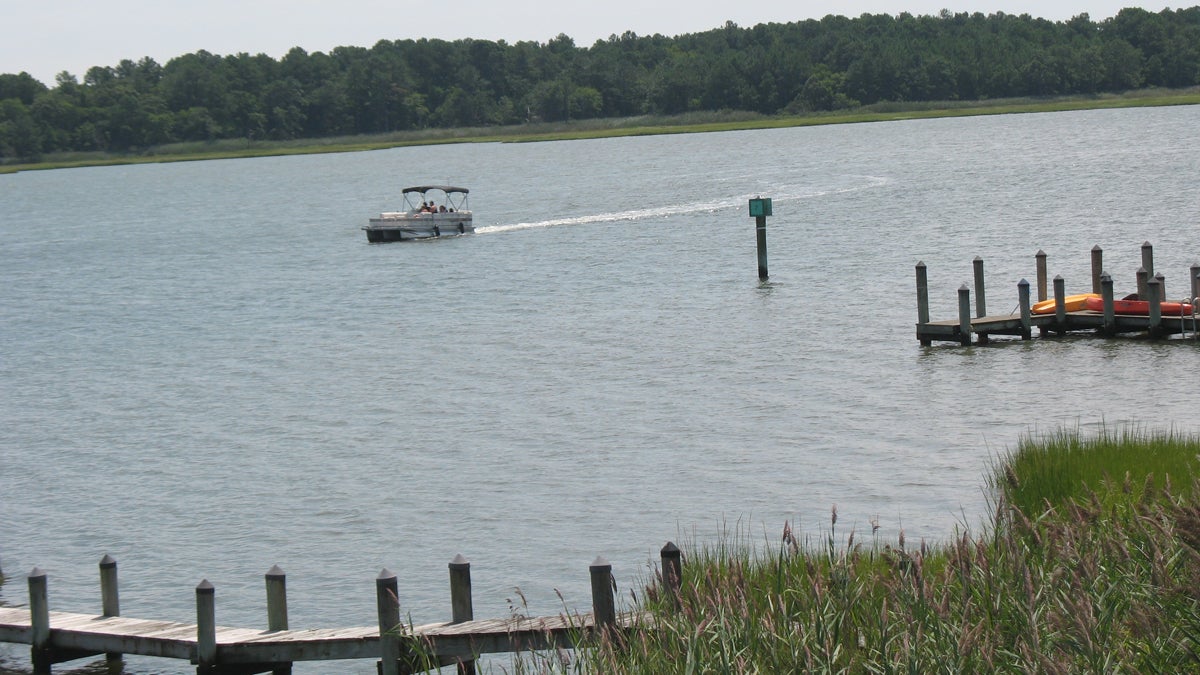Long wait for farmed oysters in Delaware to end soon

A boat passes Beach Cove in Delaware's Inland Bays near Bethany Beach. (John Mussoni/WHYY)
Regulations years in the making that will allow oysters and clams to be farmed in Delaware will be finalized “soon,” state officials say.
The Delaware Department of Natural Resources and Environmental Control is reviewing public protests over the siting of shellfish lease plots in the state’s inland bays and will provide updated locations shortly to the Army Corps of Engineers, which must approve the state program.
As appetites for oysters around dinner tables increase, shellfish farms up and down the East Coast are reviving stocks of a once plentiful creature.
Bringing oysters back to East Coast through farming
The East Coast of the United States has historically been a fertile area for growing oysters. But starting around 1900, over-harvesting, disease and declining water quality reduced the natural stock of shellfish to just a tiny fraction of their former population.
Since the 1980s, states have started farming oysters to help revive their shellfish industries and supplement catches of native stock. Delaware is trying to do the same, but efforts to start a shellfish aquaculture industry in the state have been stalled by protests from homeowners and businesses along Delaware’s inland bays.
“Every state along the Eastern Seaboard with the exception of Delaware has commercial shellfish aquaculture activity,” said John Ewart, aquaculture and fisheries specialist at the University of Delaware.
Ewart, who has researched oysters since the 1970s, has spent years trying to bring oyster and clam aquaculture to Delaware. Due largely to advocacy by Ewart and research done by a team from the Center for the Inland Bays , in August of 2013 Gov. Jack Markell signed legislation to streamline the application process for those seeking to grow oysters and clams in the state. The law effectively allowed shellfish farming in Delaware’s waters for the first time.
By 2014, the Delaware Department of Natural Resources and Environmental Control had identified 442 acres in Rehoboth Bay, Little Assawoman Bay, and Indian River Bay to lease for oyster and clam farming.
The sites took up at most 10 percent of bay acreage, but when some of those who live and work on those bays got wind of the proposed shellfish lease sites after preliminary regulations had been written, they weren’t happy.
Beach Cove residents led the protest
“I’m not against oysters, I’m not against aquaculture, in the right spots,” said David Green, a founding member of the Coalition to Save Beach Cove.
“But we’re very concerned about the environmental impact on Beach Cove, about the navigational challenges, the recreational challenges, (and) aesthetically, of course, it’s not going to be very pleasant to look at.”
Green built his dream house on Beach Cove, a small cove on the southeast side of Indian River Bay, just north of Bethany Beach. Green calls it “peaceful and serene,” and doesn’t want the view marred by up to 24 acres of oyster beds, with PVC piping and buoys sticking out of the water to mark the plots.
Green’s group of roughly 300 neighbors contends some of the proposed bed sites are in an unmarked channel in the cove, and that blocking it would prevent boats from navigating out of the cove into Indian River Bay at low tide.
After a review, the Army Corps of Engineers has suggested state regulators get rid of five of the 24 one-acre plots to allow for boat navigation.
“It’s a compromise, it’s not a great compromise though, because all of the other concerns we have … all remain,” Green said.
In Little Assawoman Bay, concerns from water-based businesses
In Little Assawoman Bay, inland from Fenwick Island, Jenifer Adams-Mitchell is worried shellfish beds will hurt her kayak and sailboat rental business, Coastal Kayaks.
“At low tides, kayakers and paddleboarders are not going to be able to go around them, on the inside of them, on the shoreline, which is where we like to keep all of our paddlers,” Adams-Mitchell said.
She’s also bothered that she did not know about the proposed shellfish regulations until a draft had already been written.
“Our problem with it is that so many of the people that live and work on the bay were not included in the initial decision-making process of where to place the plots,” Adams-Mitchell said.
Waiting for word from the state
The Army Corps of Engineers has to approve the lease sites eligible for a streamlined application process under Delaware’s 2013 law. The corps has given its feedback on the state’s plan, based largely on input from citizens including Adams-Mitchell and John Ewart.
Now, the Delaware Department of Natural Resources and Environmental Control must submit revised location information to the Army Corps for final review. In a statement, the agency said it will do so “soon” but declined to provide further details.
Ewart believes the sites will be finalized by November. If that happens, watermen could begin planting oysters in the bays this spring.
Delaware lawmakers estimate shellfish aquaculture could generate an income of $2.5 million per year in Delaware.
Ewart argues farmed oysters are good not just for the economy of the region, but also for water quality.
“They filter the water, that’s how they get their food, so they help clarify the water, which allows sunlight to go deeper down and helps submerged aquatic plants, which is habitat for small fish and invertebrates,” he said.
“And then they, themselves, when they form reefs, provides structure, and habitat for a lot of little critters.”
Legend has it there once were so many oysters in the bay that when John Smith was exploring the Chesapeake Bay in the early 1600s, his ship ran aground on oyster reefs.
“It’s not anything like it was, but aquaculture is at least helping move things back in the other direction,” Ewart said.
WHYY is your source for fact-based, in-depth journalism and information. As a nonprofit organization, we rely on financial support from readers like you. Please give today.



